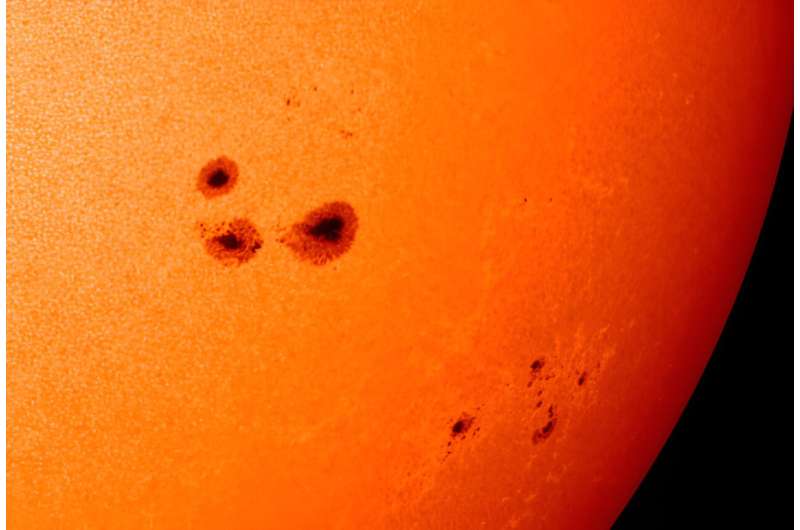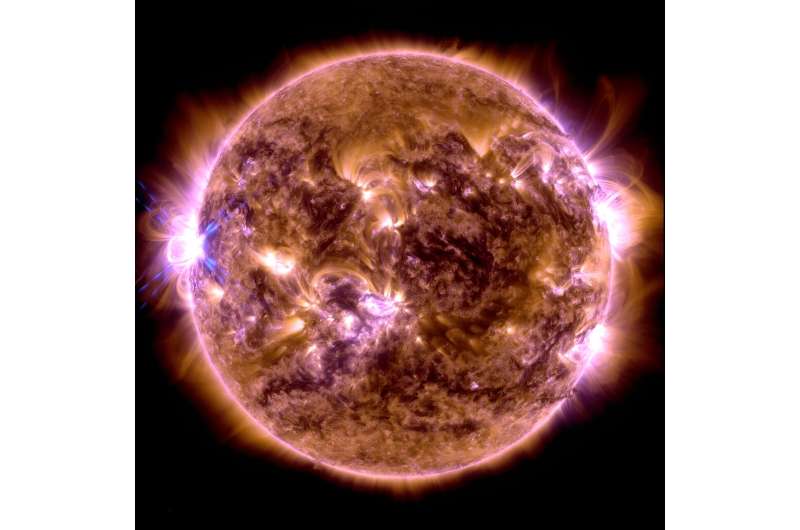This article has been reviewed according to Science X's editorial process and policies. Editors have highlighted the following attributes while ensuring the content's credibility:
fact-checked
trusted source
proofread
What the next solar maximum means for you

Much like the Earth, our sun is a dynamic body with a complex—and sometimes violent—weather system. Solar storms eject highly energetic radiation that can impact our planet, forming strong auroras and disrupting power grids, electronics, and satellites.
The scientific study of space weather attempts to understand, track, and forecast this solar activity, which peaks with the solar maximum every 11 years. The current solar cycle is predicted to peak in 2024. So, what might this mean for you?
Solar power to the max
From Earth, the sun appears relatively constant. It rises and sets, providing a steady stream of energy that sustains almost all life on our planet. But when viewed in other wavelengths, such as radio or X-rays, it becomes clear the sun is changing all the time.
Electrically conductive plasma churns and flows beneath the surface, forming powerful bundles of magnetic fields. When these rise to the surface, they create sunspots—dark patches of cooler plasma. sunspots are an important tool in tracking the likelihood of a major space weather event.
Dr. Mark Cheung is our Science Director for Space and Astronomy. "Magnetic fields within sunspots are comparable in strength to an MRI machine, but the size of entire planets," Mark said.
When sunspots collide, it stresses the magnetic bundles until they snap. This leads to solar flares and eruptions. Ultraviolet and X-ray radiation from flares puff up our outer atmosphere, reaching Earth in under nine minutes. This radiation increases drag on satellites and can also disturb the ionosphere, causing radio blackouts and leading to strong auroras.
Heavier particles, such as protons, take about 15 minutes to reach the Earth. These "Solar Energetic Particles" can damage the electronics of satellites in orbit. They can even increase the radiation dose experienced by passengers and crew on flights near the poles.
In more extreme cases, entire bundles of magnetic plasma—a coronal mass ejection (CME)—can be flung toward Earth. CMEs travel at thousands of kilometers per second. If aligned just right with the Earth's magnetosphere, they can have an enormous impact.
"The bundles of magnetic fields and charged materials can hit us like ringing a bell, intensely shaking Earth's magnetosphere," Mark said.
"Regional power blackouts could occur, satellites could sustain heavy damage, and oil pipelines could experience faster corrosion."
Sunspot numbers wax and wane over an 11-year cycle, with the greatest number appearing during solar maximum. More sunspots mean more collisions, leading to stronger space weather.
Identify, track, predict
Flares are rated on a scale from A, B, C, M, to X—with X being the strongest.
An X2.8 flare in mid-December 2023 was quickly eclipsed on 1 January 2024, with the same location birthing an X5.0 flare. This is the strongest flare seen since 2017.

"That was by far the biggest fireworks in the solar system—a good way to ring in 2024," Mark said.
While typically only visible in the far north and far south of the globe, stronger flares and CMEs can make auroras visible closer to the equator. And with solar activity increasing as we head towards the maximum, skywatchers can expect to see more auroras.
The science of predicting individual flare events is advancing rapidly, thanks to a raft of terrestrial and space-based observatories, along with machine learning for space weather forecasting.
Spacecraft like NASA's Solar Dynamics Observatory (SDO) are on the frontline of space weather science. SDO makes regular measurements of the sun's magnetic field to track changes in its surface and interior over time.
"That has allowed people to track the geometry of magnetic fields and the evolution of sunspots, which are proxies for upcoming solar flares and eruptions," Mark said.
However, observations from SDO can't tell us whether a CME is headed straight for Earth, on track for a glancing blow, or magnetically aligned with Earth's magnetosphere.
For those kinds of insights, we need to head back to the ground—to our portfolio of radio observatories. Radio telescopes at Inyarrimanha Ilgari Bundara, our Murchison Radio-astronomy Observatory in Western Australia can measure interplanetary scintillation, a kind of "twinkling" caused by solar wind.
"If the solar wind changes, the twinkling also changes, and we have a shot at monitoring the solar wind and ejections," Mark said.
Our research scientist Dr. John Morgan is working to advance our capability with interplanetary scintillation and similar observing techniques.
"Space Weather scientists internationally have an impressive array of instrumentation for monitoring the sun in exquisite detail," John said.
"What we are trying to develop is the ability to track a CME during its journey from the sun to the Earth. This almost unique capability would have the potential to vastly improve our forecasting capabilities."
A coordinated effort
The Bureau of Meteorology is the Australian Government's lead agency in space weather and operates the Australian Space Weather Forecasting Center.
Through the Forecasting Center, the Bureau provides space weather information and warning services to potentially affected industries, government agencies, including the Department of Defense, Department of Home Affairs and National Situation Room, and the community.
Its capability is focused on severe to extreme events that may threaten critical infrastructure, including radio communications, satellite operations, GPS navigation, mineral exploration, pipeline protection and electricity supply networks. The Bureau works closely with the space industry and operations that can be affected by space weather events—such as the aviation, energy, defense and telecommunication industries—to tailor forecasts and warnings to their specific needs.
The Bureau's Space Weather Observation Network spans the Australasian region and Antarctica, and includes the Learmonth Solar Observatory, a network of magnetometers, riometers and ionosondes to provide continuous, real-time observations, and global navigation satellite system total electron content scintillation monitors. The Bureau also exchanges data with Australian and international organizations.
Accurate and timely warnings are important to provide airlines time to re-route planes, satellite operators time to tweak their orbits, and communities the opportunity to prepare for power or radio blackouts.
Provided by CSIRO





















